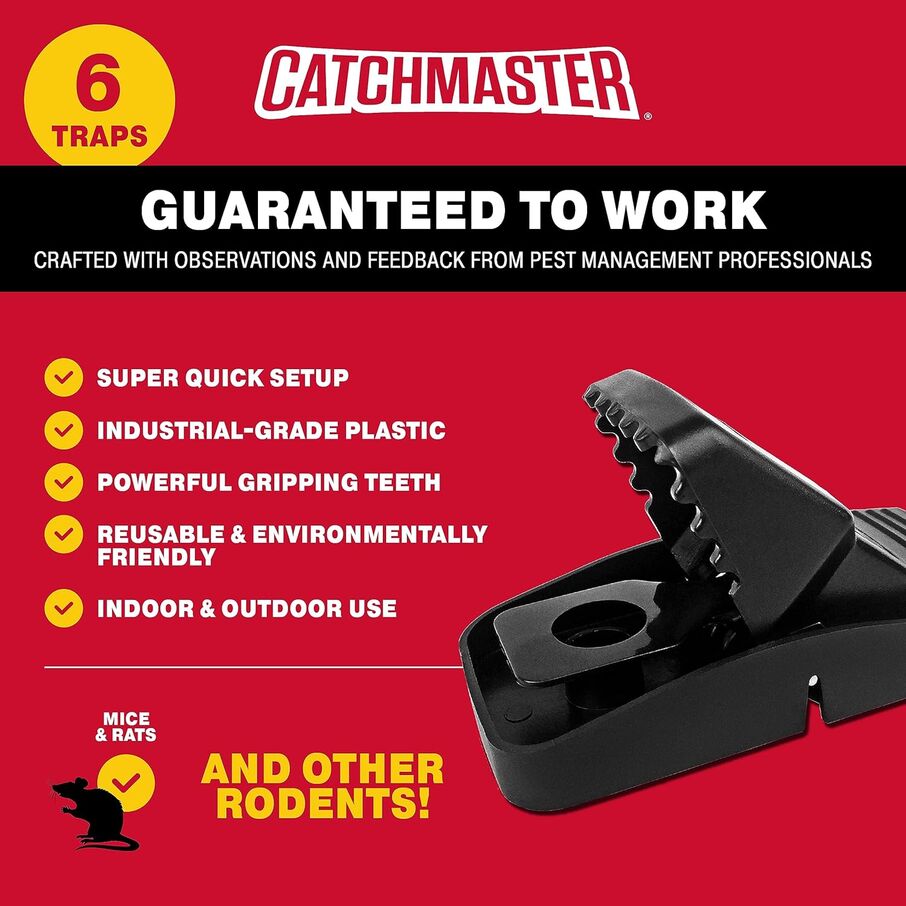To ensure the best results with your Catchmaster rat traps, follow these steps.
1. Identify High-Traffic Areas
Look for signs of rat activity such as droppings, grease marks, gnaw marks, or nests. Rats typically travel along walls, pipes, and rafters. Common high-traffic areas include:
- Along walls in attics, basements, and inside garages.
- Behind large appliances
- Near food sources in kitchens and pantries
- Around garbage areas.
Rats tend to follow established routes, so identifying these areas is crucial for successful trapping.
2. Clean and Prepare the Area
Remove alternative food sources and clean surfaces thoroughly. Rats are attracted to easily accessible food, so eliminating these attractions will make your traps more enticing. Pay special attention to:
- Sealing food in airtight containers.
- Cleaning up spills and crumbs promptly.
- Removing outdoor food sources like pet food or unsealed garbage.
A clean area ensures that your trap bait becomes the primary attraction for rats.
3. Place Traps Strategically
Position traps along walls where rats typically travel. Rats are often wary of new objects in their environment, so it may take a few days for them to approach traps. To increase effectiveness, follow these tips:
- For Glue Traps: Place them along walls 4-6 feet apart, but keep the cover on for a few days to allow rats to become accustomed to their presence. After 3-5 days, remove the cover to activate the trap.
- For Snap Traps: Set them perpendicular to the wall with the trigger end facing the wall. You may want to bait the traps without setting them for a few days to encourage rats to interact with them before actually activating the traps.
- Use Multiple Traps: Place several traps in areas with high rat activity, spacing them about 15-20 feet apart. Rats often travel in groups, so setting up multiple traps increases the chance of catching more rats.
- Be Patient: It may take several days or even weeks for rats to approach and interact with the traps, but your persistence will pay off. The wait will be worth it once you start seeing the results.
4. Use Proper Baiting Techniques
For snap traps, choose baits rats love like peanut butter, chocolate, or bacon. Use only a small amount of bait to prevent rats from stealing it without triggering the trap, and change baits regularly to maintain freshness.
For pre-baited glue traps, ensure the scented area is exposed, and never use additional bait with glue boards or trays. Adding extra bait to glue traps can compromise the adhesive’s effectiveness and attract pests away from the trap.
5. Handle Traps with Care
Always wear gloves when setting, checking, or disposing of traps. This serves two purposes: preventing your scent from getting on the traps, which may keep the rats away, and protecting you from potential diseases carried by rats or their droppings.
6. Monitor and Maintain Traps Regularly
Check traps daily and dispose of caught rats promptly. Regular monitoring ensures:
- Quick removal of captured rats, preventing odors that could attract other kinds of pests.
- Opportunity to reset or replace traps as needed to keep the traps in working condition.
- Ability to assess the effectiveness of your trapping strategy.
7. Reuse or Replace As Needed
For reusable traps like snap traps:
- Clean them thoroughly with disinfectant after each use.
- Inspect for damage and replace if necessary.
- Re-bait and reset in the same or new location.
For single-use traps like glue boards:
- Dispose of the entire trap once a rat is caught.
- Replace with a new trap in the same location.
Remember, safety first! While Catchmaster traps are designed to be non-toxic, it’s still important to keep all traps out of reach of children and pets. Even non-toxic traps can pose risks if mishandled or if a caught animal is in the trap.
Keeping Your Family Safe
Always place traps in areas where curious hands or paws can’t reach them, and supervise any areas where traps are set. When checking or disposing of traps, always wear gloves and wash your hands thoroughly after handling them. Your family’s safety is top priority in creating a pest-free home.
By carefully following these steps, you’ll maximize the success of your Catchmaster rat traps, bringing you closer to a rat-free environment and providing a sense of security and comfort.
In addition to using Catchmaster rat traps, take these steps to prevent future infestations:
- Seal entry points around your home’s exterior.
- Store food in airtight containers and clean up spills promptly.
- Keep outdoor areas clean and free of debris.
- Trim vegetation away from your home’s foundation.
- Use a combination of trapping methods for comprehensive coverage.
- Regularly inspect your property for signs of rat activity.
By implementing these preventative measures alongside your Catchmaster rat traps, you’re not just solving your current pest problem, you’re safeguarding your home for the future. Remember, effective rat control is an ongoing process that combines vigilance, cleanliness, and the right tools.
With Catchmaster products and these proactive strategies, you’re well-equipped to maintain a rat-free environment for you and your family. Stay one step ahead of potential infestations and enjoy the comfort of a safe, clean home.



















































